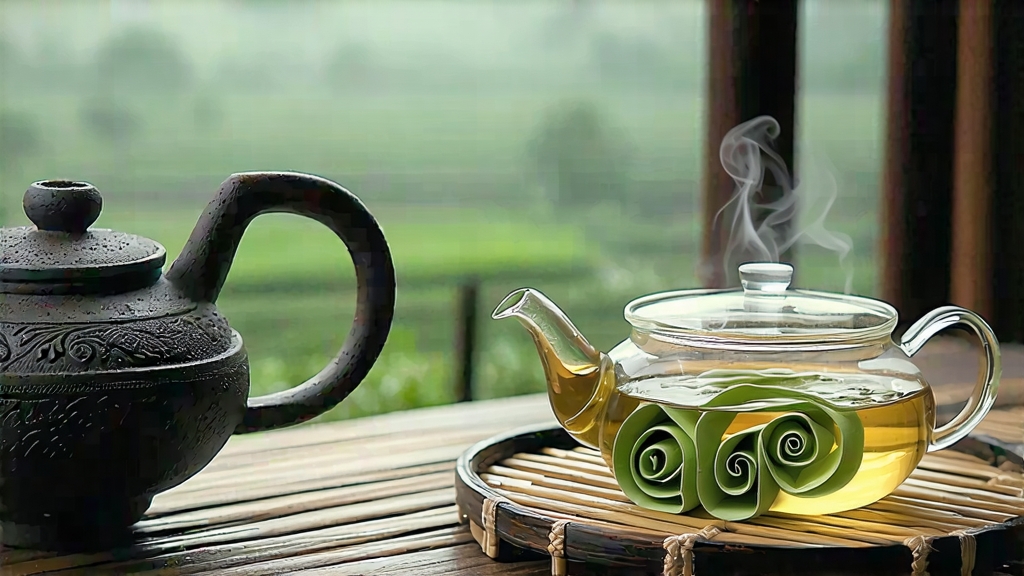
Tucked between the mist-laden banks of Lake Tai and the Dongting mountain islets in Jiangsu province grows a tea so delicate that one kilogram needs roughly seventy thousand buds. International markets often translate its name as “Green Snail Spring,” yet the Chinese characters 碧螺春 (Bi-luo-chun) literally mean “Green Conch of Spring,” a poetic tribute to the tiny spiral shape each leaf takes after being hand-rubbed across the hot surface of a copper wok. Revered since the late Ming dynasty, Biluochun was originally known as “Xia Sha Ren Xiang”—literally “Scary Fragrance”—because court ladies feared its penetrating aroma would betray their secret tea breaks. The Kangxi Emperor, enchanted by the cup during his southern inspection tour of 1699, renamed it to celebrate both its color and its harvest season, thereby elevating it to tribute-tea status alongside Longjing and Huangshan Maofeng.
Although all Biluochun comes from the same genetic cultivar—Camellia sinensis var. sinensis cv. Fuding Da Bai Ye—micro-climates and soil chemistry divide the appellation into two legally protected ecotypes. The core “Original Mountain” zone covers only Dongting East and West Mountains, two granite islands where peach, plum and loquat trees are inter-planted to perfume the tea buds. Leaves picked here fetch prices ten times higher than those from the “Extended Lake” gardens on the adjacent plains, yet both areas share the same picking rule: only the single apical bud plus the immediate unfolding leaf, plucked before the Qingming festival when morning temperatures hover around 12 °C. Such stringent timing yields an ultra-short harvest window of roughly fifteen days, making Biluochun one of China’s scarcest green teas.
Processing begins within minutes of plucking. Bamboo baskets lined with nettle cloth are rushed to the village alleyways where master tea makers have already heated their woks to 180 °C. Unlike Longjing’s pressing flattening motion, Biluochun crafting relies on a three-step spiral rub: kill-green (shaqing) lasts forty-five seconds, just enough to destroy leaf enzymes while locking in the bright jade color; the subsequent cuo-tuan (rolling into tiny spirals) demands wrist coordination so precise that veterans compare it to “turning pearls in the palm”; finally, the hong-gan (reductive drying) drops the temperature to 60 °C for twenty minutes, tightening the curls and reducing moisture to five percent. Throughout, artisans judge readiness by ear—listening for the rustle of leaves sliding across metal—and by nose, waiting for the moment when fruity notes eclipse grassy ones. The entire cycle, from tree to finished tea, is completed before sunset of the same day, preserving a freshness that connoisseurs liken to “bottled spring breeze.”
Western drinkers often brew green tea with boiling water and then complain of bitterness; Biluochun punishes such carelessness instantly. The ideal cup starts with mountain spring water filtered to 50 ppm total dissolved solids, heated to 75 °C. A 3-gram portion—about one level teaspoon—goes into a 200 ml heat-proof glass, allowing the spectacle of “three-stage sinking.” First pour, one-third of the volume, bathes the spirals until they emit a faint white down; second pour, up to two-thirds, coaxes the leaves to dance mid-depth; final pour fills the vessel, whereupon the curls unfurl and drift downward like tiny green comets. Steep for seven minutes; the extended infusion compensates for the low temperature, extracting amino acids without excessive catechins. The resulting liquor glows pale jonquil, releasing an aroma that oscillates between white peach and ripe loquat, underpinned by a marine hint reminiscent of nori. Because Biluochun’s cell walls are exceptionally thin, it tolerates up to four infusions, each revealing a new facet: first, floral lift; second, creamy chestnut; third, mineral wet stone; fourth, a sweet, almost vanilla finish.
Professional cupping follows a more ritualized path. Warmed porcelain gaiwans of 100 ml are dosed with 5 grams, flash-infused for five seconds, then decanted to aroma cups. Judges evaluate dry-leaf appearance for three visual metrics: the percentage of tips (≥90 %), the uniformity of spiral tightness (standard deviation ≤0.3 mm), and the presence of trichomes visible under 10× magnification. Infused leaf is